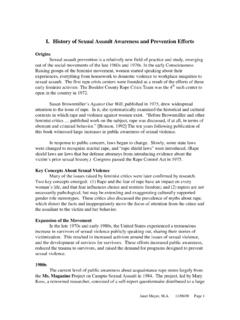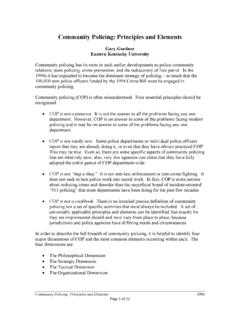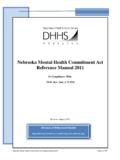Transcription of The DELTA Program - National Center on Domestic …
1 At A GlanceThe DELTA Program :Preventing Intimate Partner Violencein the United StatesCDC s DELTA Program Grantees*A list of Grantees is provided on page 3. To stop intimate partner violence, we must not only act responsibly and compassionately afterviolence has occurred, but work more diligently to prevent it from occurring in the first s DELTA Program is leading the way by promoting comprehensive strategies aimed atpreventing first time victimization and perpetration. Anne Menard, DirectorNational Resource Center on Domestic ViolenceDepartment of Health and Human ServicesCenters for Disease Control and PreventionSAFER HEALTHIER PEOPLETMThe Public Health Problem of Intimate Partner ViolenceIntimate partner violence (IPV) is a significant publicand suicide attempts that can harm their health. For 2003,health problem with serious consequences for victims,CDC estimated medical and other costs associated withfamilies, and communities.
2 The term intimate partnerIPV against women as exceeding $ billion refers to physical, sexual, or emotional abuseResearch shows that IPV can range from single orby a current or former partner or spouse. In 2005, moreoccasional acts of violence to more frequent and inten-than 1,110 women and 330 men died as a result of acts of violence that are characterized by oneThat same year, CDC s Behavioral Risk Factor Surveil-partner attempting to develop and maintain control overlance System collected data from more than 70,000 adultsthe other. All forms of IPV can be 16 states and two territories on IPV suggest that percent of women and provides funding, networking opportunities,percent of men were victims of physical or sexual IPVtraining, and technical assistance to support primaryduring their lifetime.
3 IPV is linked with serious healthprevention of IPV. Primary prevention means stoppingproblems for women, including chronic pain, reproductiveIPV before it occurs, rather than responding once itdisorders, depression, and post-traumatic stress or working to prevent its recurrence. PrimaryWomen who have experienced IPV are more likely toprevention focuses on strategies to stop both first-timeengage in other behaviors, such as drug abuse, alcoholism,perpetration and first-time Intimate Partner Violence Through DELTAThe Family Violence Prevention Services Act (FVPSA)In 2002, CDC used FVPSA funding to develop theauthorizes CDC to distribute federal funds to supportDomestic Violence Prevention Enhancements andcoordinated community responses (CCRs) that addressLeadership Through Alliances ( DELTA ) Program whoseIPV.
4 A CCR is an organized effort to prevent andfocus is the primary prevention of IPV at the commu-respond to IPV in a community. It typically coordinatesnity level. Through the DELTA Program , CDC funds 14the work of diverse service sectors, such as organiza-state-level Domestic violence coalitions (SDVCs) totions involved in victim services, law enforcement,provide prevention-focused training, technical assis-prosecution, public health, and faith-based , and financial support to local CCRs. Local CCRsHistorically, CCRs have focused on providing servicesthen develop and implement strategies focused onto victims, holding perpetrators accountable, andpreventing first-time perpetration and the number of recurring Level:Centers for DiseaseControl and Prevention Funds State DomesticViolence Coalitions (SDVC)in 14 states Leads the National DELTAP rogram by providing tools,training, and technicalassistance to enable SDVCsto support and evaluate IPVprimary prevention efforts intheir states Conducts a cross-siteevaluation of effectivenessof training and technicalassistance activitiesState Level.
5 State DomesticViolence Coalitions Fund CCRs in their states Provide tools, training, andtechnical assistance to fundedCCRs to promote primaryprevention and to buildcapacity to plan, implement,and evaluate primaryprevention strategies andactivities Work with state leadership tobuild capacity ( , leadership,expertise, data collectionsystems, and evaluationprocesses) for primaryprevention of IPVL ocal Level:Coordinated CommunityResponses Conduct data-driven planningto identify IPV preventionneeds in their communities Develop, implement, andevaluate evidence-supportedprimary prevention strategies Build local support forprimary prevention2 DELTA Program GranteesNorth Carolina3 The DELTA Program in ActionSDVCs that receive DELTA Program funding arenonprofit organizations that represent and support thework of local Domestic violence programs throughpublic education, public policy development, training,technical assistance, and Program many public health problems, IPV is not simply anindividual problem.
6 It is a problem rooted in commu-nity and societal norms. Prevention requires a thoroughunderstanding of primary prevention and of risk andprotective factors. It also requires strategies for changefocused on individuals as well as communities. SDVC sprovide training and technical assistance so fundedCCRs can develop and implement the multi-levelchange strategies that prevent IPV while acknowledgingthe unique needs and culture of their communities. Thefollowing sections highlight some of the preventioninitiatives developed by DELTA -supported SDVCs andlocal North Carolina Coalitiongainst Domestic Violence isartnering with the North Caro-Aplina Department of Public In- principal inV and the and Florida Coalition Againstomestic Violence incorporatesimary prevention concepts into work with the Teen Datingolence Among Runaway andg a session onstruction.
7 Within three years, every schoolthe state will receive information about IPways schools can partner with local CCRsviolence programs on primary prevention Homeless Youth Project by includinprevention in its 14 of the DELTA -fundedSDVCs have establishedeffective working relationshipswith their state public healthagency, resulting inprogrammatic and policysuccesses. For example, theKansas Coalition Against Sexual and DomesticViolence has partnered with the Kansas Department ofHealth and the Environment (KDHE) to expand CDC sChoose Respect Campaign, which encourages healthyrelationships for youth, within Kansas. The KansasCoalition has forged strong relationships with KDHE experts in the areas of injury and violence, adolescenthealth, migrant health, and Alaska Network onDomestic Violence andSexual Assault fundsJuneau s DomesticViolence Task Force CCRto implement TRAIN(Teens Resisting Abuseand Initiating Non-ucates teens about healthyolence, conflict resolution,pate in peer educationaigns such as the Whitening for IPV ).
8 This Program edrelationships, teen dating viand advocacy. Youth particiactivities, community campRibbon Campaign, and planThe Delaware Coalition AgainstDomestic Violence funds two CCRs:the Domestic Violence Task Force anthe Victims Rights Task Force. ThesCCRs have formed a preventionsubcommittee with a goal of safe andSDVC Leadership in ActionTcThDpritsVi CCR Prevention Efforts in ActionAlaskaKansas Alaska Network on Domestic Violence and Sexual Assault North Carolina Coalition Against Domestic Violence California Partnership to End Domestic Violence North Dakota Council on Abused Women s Services/Coalition Against Sexual Assault Delaware Coalition Against Domestic Violence New York State Coalition Against Domestic Violence Florida Coalition Against Domestic Violence Ohio Domestic Violence Network Kansas Coalition Against Sexual and Domestic Violence Rhode Island Coalition Against Domestic Violence Michigan Coalition Against Domestic and Sexual Violence Virginia Sexual and Domestic Violence Action Alliance Montana Coalition
9 Against Domestic and Sexual Violence Wisconsin Coalition Against Domestic ViolenceFloridaDelaware4 For more information or additional copies of this document, please contact:Centers for Disease Control and PreventionNational Center for Injury Prevention and Control4770 Buford Highway NE, Mail Stop F64, Atlanta, GA 30341 Telephone: 1-800-CDC-INFO email: DirectionsMichiganrespectful relationships for all. To make this vision areality, they have created a 12-session curriculum,Developing Healthy Relationships. The impact isbeing evaluated and the curriculum may be recom-mended by the Delaware Department of Educationto Delaware health teachers for use in the class-room. Additionally, through the DELTA Program ,teens have produced and disseminated healthyrelationship public service announcements. ThesePSAs and other helpful information for teens,parents, and teachers can be viewed , a website created byDelaware DELTA Ohio Domestic ViolenceNetwork funds the Knox CountyCCR, which is implementing theFounding Fathers Campaign toengage men in preventing s Choose Respect Campaignfocusing on healthy relationshipsfor youth, is also being implemented.
10 The CCRsupports a media literacy project to help youngpeople recognize and reject messages and imagesthat support or encourage Michigan CoalitionAgainst Domestic andSexual Violence funds theArab Community Centerfor Economic and SocialServices and theLakeshore AllianceAgainst Domestic andSexual Violence. BothCCRs held faith forums that provided resources ainformation about faith leaders roles in preventinthe first-time occurrence of IPV. As a result of thiseffort, faith leaders have increased their focus onhealthy and respectful relationships in their pre-marital counseling activities and at community ancongregational events.,OhiondgdDELTA Program EvaluationExtending the DELTA Program s ReachWithin each DELTA state, evaluators are workingCDC has partnered with the CDC Foundation andwith the SDVC and local CCRs to assess changesthe Robert Wood Johnson Foundation to extend thein state and local capacity to prevent IPV and thereach of the DELTA Program to the 36 states notimpact of each CCR s effort to prevent IPV.
















